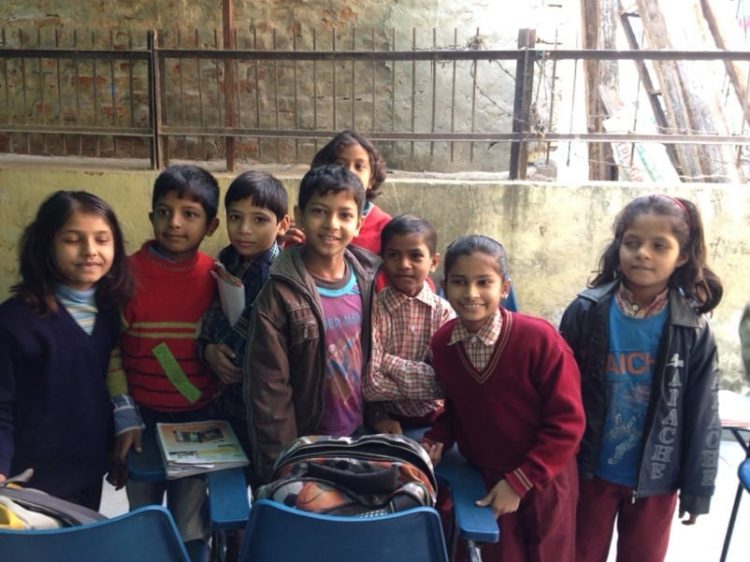We have settled into a routine with our placements. I can see how I could make a difference for some of these students. Two weeks just isn’t enough time. I am the main photographer for our group at our placement. I work with the older kids and have a little more time to myself because the students are expected to work independently when given a task. That is why there are so few photos of me at school.

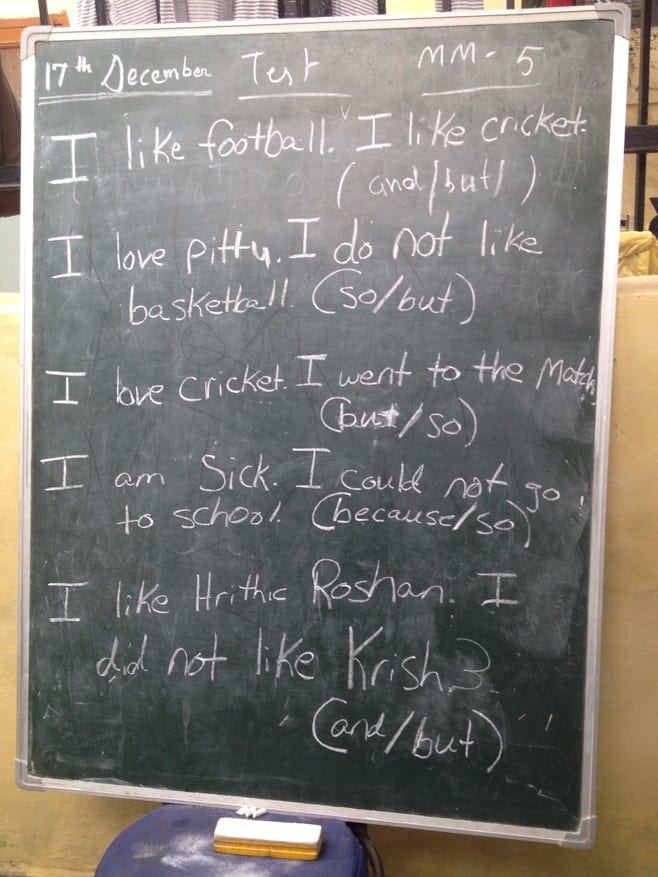
The students take these sentence pairs and make compound sentences with them. The only thing unusual about this problem set is that I am in a country working with second and third graders, and English is not their native language, Well that and some of the references. The bottom sentence refers to a Bollywood movie and an actor from it. Pittu is an active game.
After we went to our placement, I did yoga, then we went to hear a talk. Some of the girls went out to dinner but our family stayed at the flat. Our meals are all cooked at the office for us. The food has been superb. I have been inspired to come home and try making more varied Indian dishes. The food and spices are mixed up more than I do when it am home. I also like the hot food here more. I think it might just be that I don’t like jalapeños, and not that I don’t like spicy food, although I do not like it if it is too spicy.

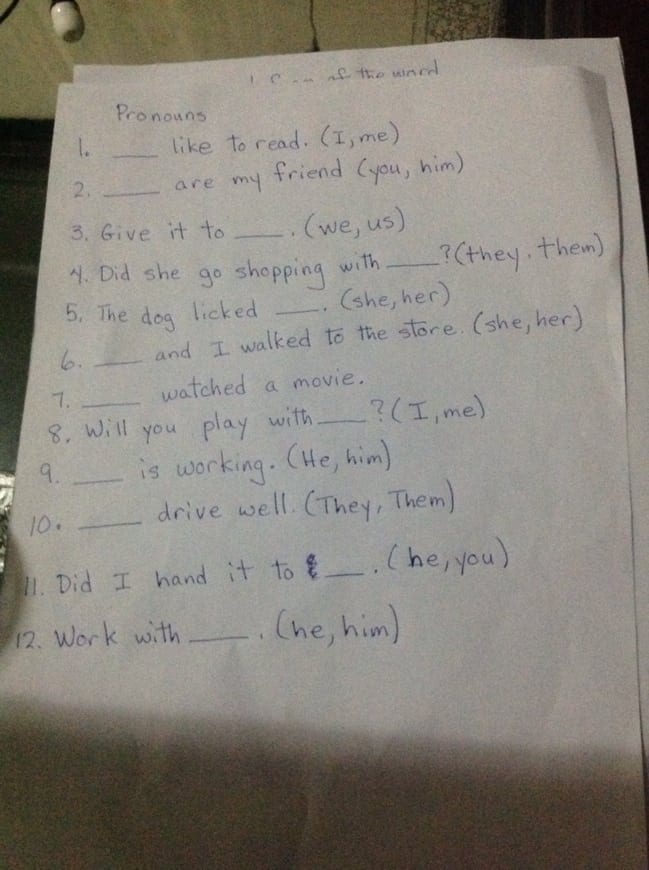
This is a worksheet I made. Yesterday I made the mistake of creating and bringing a worksheet written in cursive. I hate writing using printing. Yikes I left the answer choices off # 7! I will have to fix that.
Have I remembered to mention that they drive on the opposite side of the road in India. The driving here is really crazy, I mean really, really, very truely insane. Add the whole opposite thing in, and I could not drive in India.

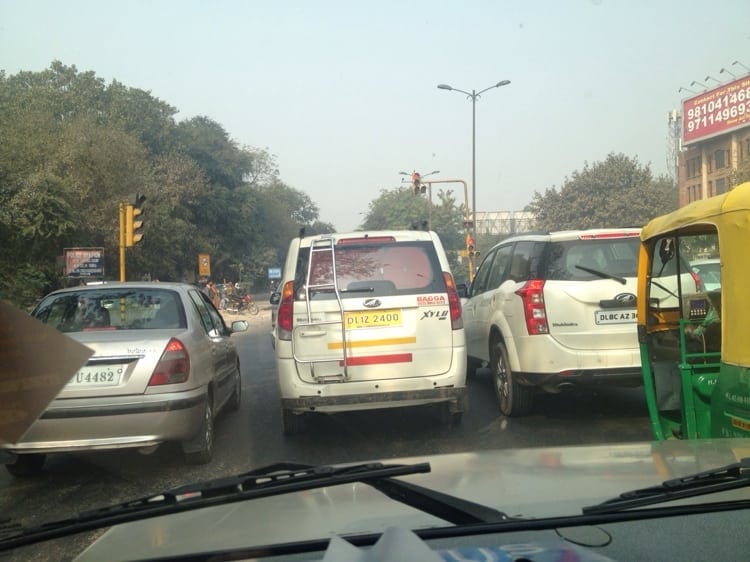
It is impossible to catch how crazy it is on a still photo. When asked about the traffic we were told by a native Indian, that the Indian people survive more by accident than by design.
Now notes from today’s talk: Dr. A. K. Ray, talked about the political history of India. Before retiring he was a professor at Jawaharlal Nehru University, JNU. All statements below unless indicated are from Dr. Ray.
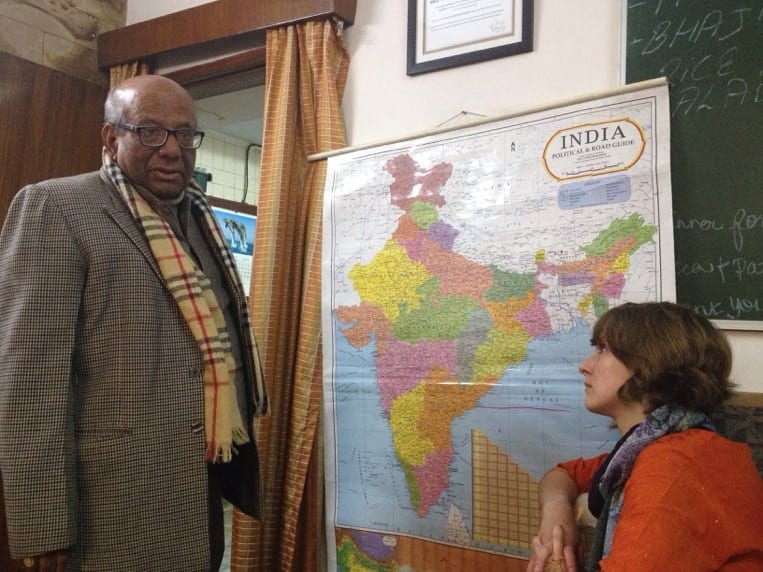
1 in every 6 people on the planet is Indian. India is 1/3 the size of the United States. India has 3 times the people as the US, which makes it 9 times more densely populated than the US.
When you look at the Indian civilization you are looking at a civilization that is 10,000 years old. Hinduism began about 8,000 years ago, and at that time they stopped eating beef. In case you did not know, Hindus do not eat beef. Most eat milk products though.
Not eating beef might seem trivial to you, but it is important when looking at something unfamiliar that you do not dismiss or trivialize the unfamiliar. 86% of Hindus do not eat beef. When you look at the health of the people and the cows you would expect them to eat beef. This is a very malnourished society. It is estimated 80% of the people in India are malnourished. This is an Indian phenomenon that leads to a high rate of death, and the cows are just as bad off. So why don’t people eat those cows? There was a phase in Hindu society when they ate beef. The Hindu society has been an agrarian society for millennia. Within that everything depends on the cow. Since the cow provides everything, plowing, food in the form of milk, and manure, it makes more sense to protect the cow than to slaughter the cow. This has led to a deification of the cow. This deification of the cow led to cows being protected from slaughter for food consumption. (My thoughts here: The Indian people do not seem to have a clear separation between the value of human life and the value of life for other animals, as is seen by most in the US. Hindus seem to just plain old value life. If you think about it, it is much more rational to value life in and of itself, than it is to have arbitrary separations and hierarchies within animal groups as to whose lives have more value.)
All Hindu Gods and Goddesses are products of myths. But these are myths that have been believed and a part of society for 8,000 years. Actually all religions are based on myths. It is all a matter of faith, and the faith of the Hindus is so old that it has become the fabric of history for the Hindu people.
As an example of this: Monkeys cannot be killed in India, because the monkey god, Hanuman, is said to have helped Lord Rama. For the tale you can go to this site, http://en.wikipedia.org/wiki/Hanuman. Today in India, monkeys get into everything, even government buildings where they have been known to destroy documents, but you cannot do anything about it because the monkey is revered.
Irrational? Yes. But it is imbedded in society. The past is deeply imbedded in the present. When Americans say forget about the past and focus on the present, Indians cannot. This is very important to understand when understanding the Indian people. For 10,000 years the Indian society has survived by being rational, even if we think it is irrational. It is our lack of understanding the Indian people and their shared history that creates this misperception.
Lifestyles here are imbedded.
There is a global fault line at Istanbul. One side is an ancient civilization, the east side including Africa, and one side is newer. In these ancient civilizations, traditions have been around a long time and die hard.

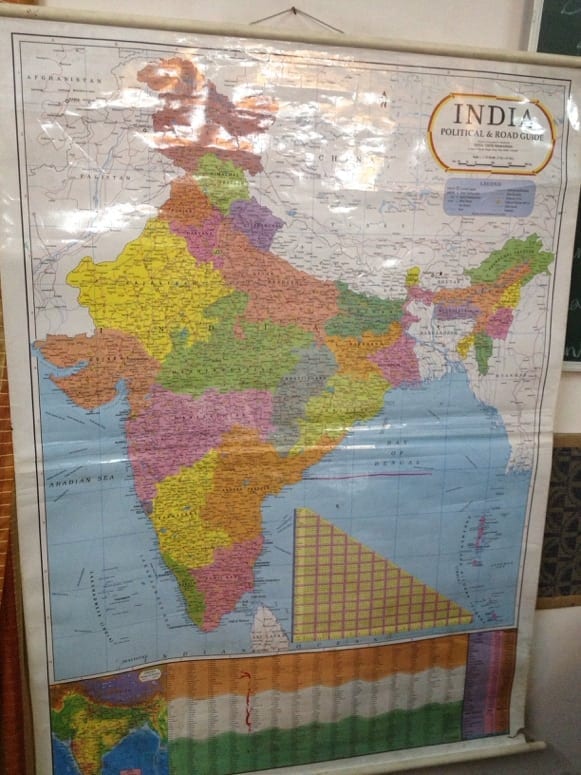
The colors on the map of India show how different Indian society is. It is divided by language, tribe, caste, and race. All of these things divide. Even Hindus are divided by language and caste. 78% of Indians are Hindus. There are more caste riots within the Hindu group than there are riots between the different religions.
India has people of many faiths and has had a long history of tolerance towards all faiths.
St. Thomas, one of the original disciples of Christ visited India. There is a population of 200,000 Jews in Kerala who can trace their roots back to Soloman.
The Zororastrians are Parsis. The Parsis originally came to India to escape the Islamic invasion in Persia (modern day Iran). The Parsis came to India because India had a reputation for accepting asylum seekers.
They are followers of Zarathushtra who lived 3000 years before Christ. Zarathushtra preached monotheism in the name of Ahurmazda who has no form shape, beginning or end. He, however, acknowledged archangels who protected humanity through the sacred elements. Parsis led a peaceful and happy life in their native land, and Zoroastrianism was quite popular in parts of Asia and Europe. But with the arrival of Islam in the 7th and 8th centuries, religious zealots invaded Persia and forcible conversions (or death) took place on a large scale. People fled to different lands. Some came to India by sea, carrying the sacred fire with them. Tradition declares that the flames were collected from potters, goldsmiths, brick makers, shepherds etc, sixteen vocations undertaken by ancient Parsis.
When the first immigrants landed on the swampy port of Navsari (Gujarat) and requested shelter and patronage of the local ruler, he sent them a bowl of milk full to the brim, indicating that though they were welcome, his land was full of inhabitants. The Parsi high Priest asked for some sugar and put it in the bowl and sent it back. The milk did not overflow and the sugar added to the taste, suggesting there would be benefits from a merger of immigrants with the existing inhabitants, and there would be eternal help to the ruler from the refugee community. The ruler was impressed. India became a second homeland to newcomers like Jews, Syrian Christians, Central Asian and African communities. All were free to follow their own faith and take up different pursuits.
The two paragraphs above are from, http://www.kamat.com/kalranga/people/zoroastrians.htm, because I wanted to get the history of this just right. My notes were fuzzy on it.
When the British left, the Indian people decided to eliminate English from schools, but they could not agree what to replace it with.
13% of Hindus are still untouchables today, but you cannot discriminate against them or you face jail time. Gandhi and another man named, Ambedkar, started converting the untouchables to Buddhism from Hinduism. Once they were Buddhists they were no longer untouchable, because Buddhists don’t have the caste system. This group of recent converts from Hinduism to Buddhism is called neo-Buddhists.
Another problem with the caste system is that the 4 principle castes led to subcastes. This created tensions within each caste group.
All the tensions, all the differences. What unites the Indian people is their civilization and cultural unity.
I will write up the last 1/2 of the lecture later today. GTG 🙂

